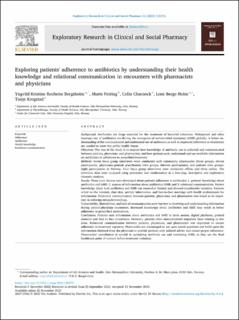| dc.description.abstract | Background: Antibiotics are drugs essential for the treatment of bacterial infections. Widespread and often
improper use of antibiotics are driving the emergence of antimicrobial resistance (AMR) globally. A better un-
derstanding of the communicated and understood use of antibiotics as well as improved adherence to treatments
are needed to meet this public health threat.
Objectives: The aim of the study is to explore how knowledge of antibiotic use is collected and communicated
between patients, physicians, and pharmacists, and how patients seek, understand and use available information
on antibiotics in adherence to prescribed treatment.
Methods: Seven focus group interviews were conducted with community pharmacists (three groups, eleven
participants), physicians/general practitioners (two groups, thirteen participants), and patients (two groups,
eight participants) in Norway. Four focus group interviews were conducted offline and three online. The
interview data were analyzed using systematic text condensation in a four-step, descriptive and explorative
thematic analysis.
Results: Three main themes were developed about patients' adherence to antibiotics: 1. patients' knowledge about
antibiotics and AMR; 2. sources of information about antibiotics/AMR; and 3. relational communication. Patient
knowledge about both antibiotics and AMR was somewhat limited, and showed considerable variation. Patients
relied on the internet, chat sites, printed information, and face-to-face meetings with health professionals for
information. Relational communication between patients, physicians, and pharmacists was found to be impor-
tant in reducing misunderstandings.
Vulnerability, limited time, and lack of communication were barriers to receiving and understanding information
during patient-physician encounters. Increased knowledge about antibiotics and AMR may result in better
adherence to prescribed medications.
Conclusions: Patients seek information about antibiotics and AMR in three arenas; digital platforms, printed
material and face to face encounters. However, patients often misunderstand important facts relating to this
issue. Relational communication between patients, physicians, and pharmacists was important to ensure
adherence to treatment regimens. Pharmacists are encouraged to use open-ended questions and build upon the
information obtained from the physician to provide patients with tailored advice and ensure proper adherence.
Pharmacists' contribution is crucial in optimizing antibiotic use and combating AMR, as they are the final
healthcare point of contact before treatment initiation. | en_US |

